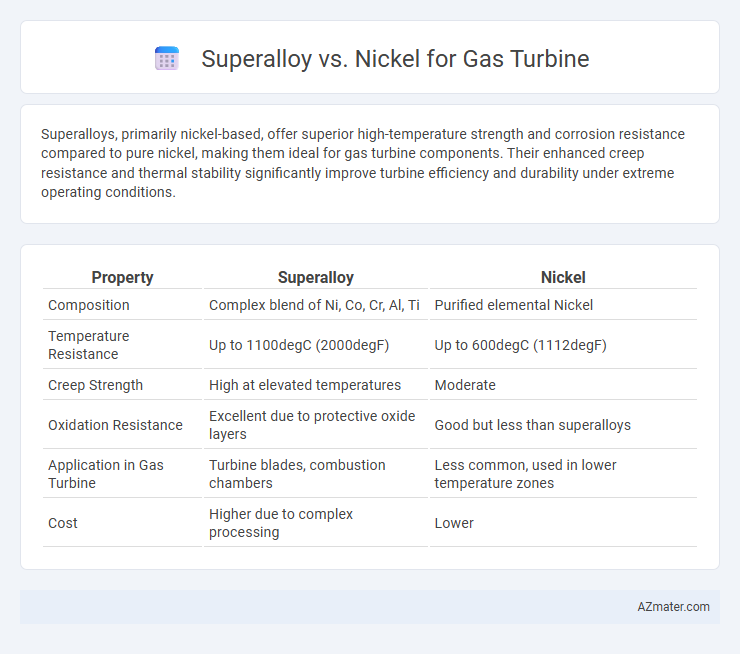Superalloys, primarily nickel-based, offer superior high-temperature strength and corrosion resistance compared to pure nickel, making them ideal for gas turbine components. Their enhanced creep resistance and thermal stability significantly improve turbine efficiency and durability under extreme operating conditions.
Table of Comparison
| Property | Superalloy | Nickel |
|---|---|---|
| Composition | Complex blend of Ni, Co, Cr, Al, Ti | Purified elemental Nickel |
| Temperature Resistance | Up to 1100degC (2000degF) | Up to 600degC (1112degF) |
| Creep Strength | High at elevated temperatures | Moderate |
| Oxidation Resistance | Excellent due to protective oxide layers | Good but less than superalloys |
| Application in Gas Turbine | Turbine blades, combustion chambers | Less common, used in lower temperature zones |
| Cost | Higher due to complex processing | Lower |
Introduction to Gas Turbine Materials
Gas turbines require materials with exceptional high-temperature strength, corrosion resistance, and thermal stability to withstand extreme operating conditions. Superalloys, predominantly based on nickel, cobalt, or iron, are engineered to maintain mechanical integrity and resist oxidation at temperatures exceeding 700degC, making them ideal for turbine blades and other critical components. Nickel-based superalloys dominate gas turbine applications due to their superior creep resistance and phase stability compared to conventional nickel or steel alloys.
Overview of Superalloys
Superalloys, primarily based on nickel, cobalt, or iron, are engineered for exceptional strength, corrosion resistance, and thermal stability in gas turbine applications. Nickel-based superalloys dominate the industry due to their superior high-temperature performance and ability to maintain mechanical integrity above 700degC. These materials enable gas turbines to operate efficiently under extreme thermal and mechanical stresses, significantly improving engine lifespan and fuel efficiency compared to conventional nickel alloys.
Properties of Nickel in Gas Turbine Applications
Nickel exhibits exceptional corrosion resistance and high-temperature strength, making it a critical element in gas turbine components exposed to extreme operating conditions. Its ability to maintain mechanical properties at temperatures exceeding 700degC enhances turbine efficiency and lifespan. The formation of stable oxide layers on nickel surfaces provides superior oxidation resistance, crucial for gas turbine blades and vanes.
Comparative Mechanical Strength
Superalloys, primarily based on nickel, cobalt, or iron, exhibit superior mechanical strength at high temperatures compared to pure nickel due to their complex alloying elements such as chromium, aluminum, and titanium. Nickel-based superalloys maintain exceptional creep resistance, tensile strength, and oxidation resistance above 700degC, crucial for the extreme thermal environments in gas turbines. In contrast, pure nickel lacks the enhanced microstructural stability and strengthening phases, resulting in significantly lower mechanical performance under turbine operating conditions.
High-Temperature Performance
Superalloys, primarily based on nickel, cobalt, or iron, exhibit superior high-temperature performance compared to pure nickel due to their enhanced phase stability and resistance to creep, oxidation, and thermal fatigue. Nickel-based superalloys used in gas turbines can maintain strength and corrosion resistance at temperatures exceeding 1,000degC, enabling higher turbine inlet temperatures and improved engine efficiency. The addition of elements such as chromium, aluminum, and titanium in superalloys forms protective oxide layers and precipitates that significantly enhance thermal resistance beyond that of pure nickel.
Corrosion and Oxidation Resistance
Superalloys exhibit superior corrosion and oxidation resistance compared to pure nickel in gas turbine applications due to their complex alloying elements such as chromium, aluminum, and cobalt that form stable oxide layers at high temperatures. Nickel, while providing good baseline resistance, lacks the enhanced protective oxide scale formation that superalloys achieve, resulting in higher susceptibility to hot corrosion and oxidative degradation. Advanced superalloys sustain prolonged operational life in aggressive environments by mitigating the effects of thermal cycling and corrosive gas exposure more effectively than monolithic nickel.
Manufacturing and Fabrication Considerations
Superalloys, often based on nickel, cobalt, or iron, exhibit superior high-temperature strength and oxidation resistance essential for gas turbine components, but their complex compositions demand advanced manufacturing techniques like powder metallurgy and precision casting. Nickel alloys, a subset of superalloys, offer excellent corrosion resistance and thermal stability but require specialized fabrication processes such as hot isostatic pressing and directional solidification to achieve optimal microstructure and mechanical properties. Manufacturing challenges include controlling grain size, preventing contamination, and ensuring uniformity, making fabrication costs and process times significantly higher compared to simpler metal alloys used in turbine construction.
Cost and Availability
Superalloys, primarily based on nickel, offer superior high-temperature strength and corrosion resistance crucial for gas turbine components but come at a higher cost due to complex manufacturing and alloying elements like cobalt and chromium. Nickel alone, while more readily available and less expensive, lacks the enhanced performance characteristics needed for critical turbine parts, limiting its use in less demanding sections. The cost and availability balance makes superalloys the preferred choice for premium turbine efficiency, whereas pure nickel serves mainly as a cost-effective option in non-critical applications.
Real-World Gas Turbine Case Studies
Superalloys, especially nickel-based variants like Inconel 718 and Rene 41, dominate as materials in real-world gas turbine applications due to their exceptional high-temperature strength and oxidation resistance. Case studies from aerospace engines such as the GE90 and Rolls-Royce Trent showcase how nickel superalloys enable turbine blades to withstand temperatures exceeding 1,200degC, improving efficiency and lifespan compared to pure nickel components. These alloys' microstructural stability at elevated temperatures outperforms standard nickel, reducing creep deformation and enhancing turbine reliability in harsh operating conditions.
Future Trends in Gas Turbine Material Selection
Future trends in gas turbine material selection emphasize advanced superalloys with enhanced thermal stability, corrosion resistance, and creep strength to withstand increasingly higher operating temperatures. Innovations such as nanostructured superalloys and additive manufacturing techniques enable precise microstructural control, improving performance beyond conventional nickel-based alloys. Emerging materials research targets lightweight composites and ceramic matrix composites (CMCs) to complement or replace nickel superalloys, aiming for higher efficiency and reduced emissions in next-generation gas turbines.

Infographic: Superalloy vs Nickel for Gas Turbine
 azmater.com
azmater.com